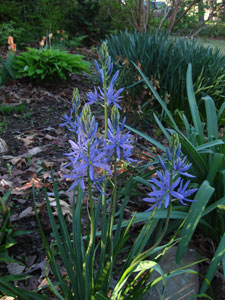Resource Library
Plant of the Week: Camass
The University of Arkansas System Division of Agriculture does not promote, support or recommend plants featured in "Plant of the Week." Please consult your local Extension office for plants suitable for your region.
Plant of the Week
Camass
Latin: Camassia leichtlinii

A bulb Meriwether Lewis would have recognized is blooming in my garden today. The bulb, one of the Camass, or Quamash, featured prominently in the journal of Captain Lewis as he and his crew of intrepid explorers headed west out of the Bitterroot Mountains into what is modern-day Idaho. This interplay between plants and human history is part of every plant’s legacy and makes its blooming that much more enjoyable.
Six species of Camass are described in North America, with the most common garden form being selections of the large camass, C. leichtlinii. The most common Western American species is C. quamash, the species Lewis encountered. Though long considered members of the lily family (where the Flora of North America still retains it), modern DNA research places them in the Agave family.
Camass are all bulbous plants found in moist meadows, along streams and in glades in the open woodland. They produce elongated tunicate bulbs to 2 inches in diameter that flower in mid-to-late spring. The succulent foliage is glaucous gray-green in color, a half-inch wide and withers away by mid-summer.
The blue, lavender or white flowers appear on an elongating scape above the foliage in with three to 10 florets open at any one time. The individual flowers have six slender tepals and are to 2 inches across. The camass cultivars of the bulb trade grow 18 to 24 inches tall when in bloom. C. scilloides, the bear camass, is native to the Eastern United States and is the most common species encountered in Arkansas. It has pale lavender flowers and is 8 to 10 inches tall when in flower.
In the fall of 1805, William Clark was leading an advance team searching for game and other provisions when they came upon Nez Perce lodges. The camp was primarily populated by women, who were busy preparing stores of quamash for the long winter that was fast approaching. The troop traded for both roasted quamash bulbs and a quamash flat bread, fare they found palatable but never really enjoyed. Up until this encounter, the troop’s diet had been exclusively meat. All complained of gastric upset with the shift in diet from red meat to salmon and quamash.
Meriwether Lewis described the steps involved in slow-roasting the bulbs to make them palatable. When cooked for about a day, the bulbs were completely black and tasted like sweet potato because the complex carbohydrate inulin breaks down to fructose. These same baked bulbs were also dried and formed into dough that was ground into flour or baked as a dried flat bread.
The next year, on their way home the troop encountered the “quawmash flats” in full bloom on June 12, 1806. In his journal, Lewis wrote, “at a short distance it resembles lakes of fine clear water, so complete is this deception that on first sight I could have sworn it was water.” These flats were actively managed by various Northwestern tribes by rouging for death camass, a poisonous bulb that looks a lot like quamash bulbs but is easily separated when in bloom. Also, the flats were burned in the fall to keep them clear of invading brush.
Lewis collected samples and the herbarium specimen made it safely back to Washington the next year. Though Lewis first collected the quamash, it fell through the botanical cracks and was not officially named until 1832 by the Englishman John Lindley, who was working from specimens provided by David Douglas, of Douglas fir fame.
Quamash is easy to grow in any reasonably well-drained garden soil suitable for bulbs. Bulbs can be grown in zones 3 to 7. It is best in full sun but adapts readily to part shade. Individual bulbs produce offsets at the base and in a few years can form dense clumps. If division is necessary, divide as the foliage is dying down in early summer.
By: Gerald Klingaman, retired
Retired Extension Horticulturist - Ornamentals
Extension News - April 22, 2011
The University of Arkansas System Division of Agriculture does not maintain lists of retail outlets where these plants can be purchased. Please check your local nursery or other retail outlets to ask about the availability of these plants for your growing area.